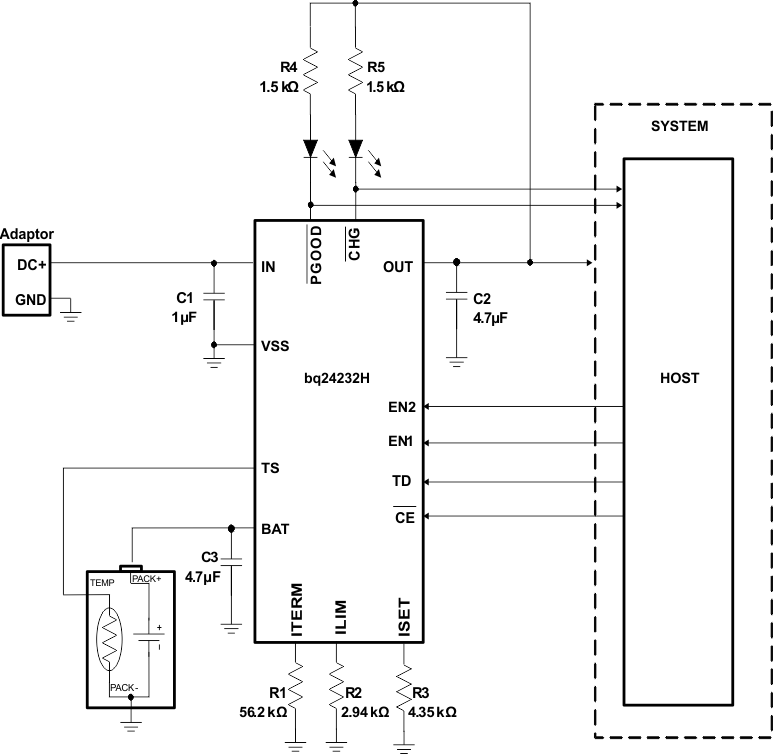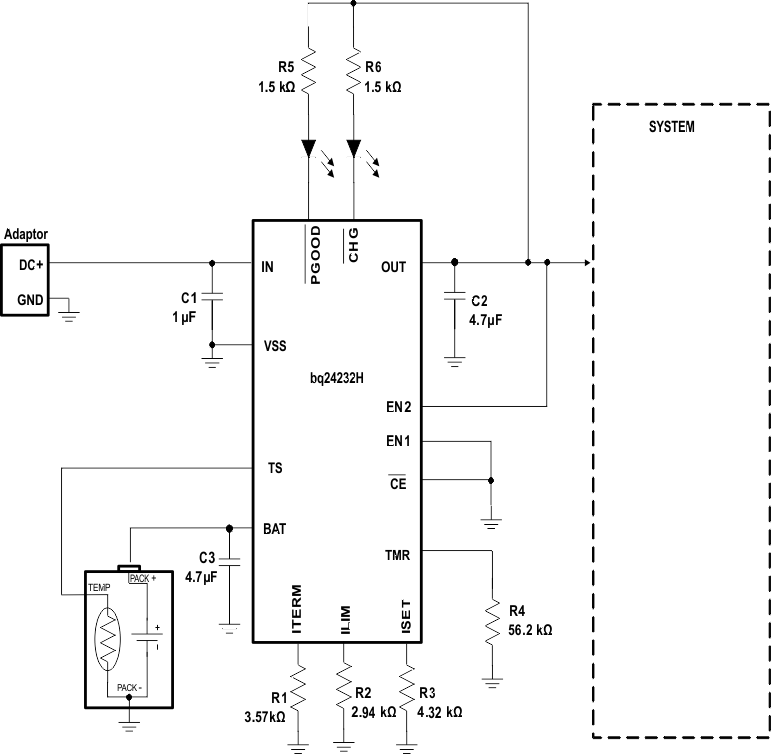ZHCSD66B January 2014 – May 2017
PRODUCTION DATA.
- 1 特性
- 2 应用范围
- 3 说明
- 4 修订历史记录
- 5 Device Comparison Table
- 6 Pin Configuration and Functions
- 7 Specifications
-
8 Detailed Description
- 8.1 Overview
- 8.2 Functional Block Diagram
- 8.3
Feature Description
- 8.3.1 Undervoltage Lockout
- 8.3.2 Power On
- 8.3.3 Power-Path Management
- 8.3.4
Battery Charging
- 8.3.4.1 Charge Current Translator
- 8.3.4.2 Battery Detection and Recharge
- 8.3.4.3 Termination Disable (TD Input, bq24230H)
- 8.3.4.4 Adjustable Termination Threshold (ITERM Input, bq24232H)
- 8.3.4.5 Dynamic Charge Timers (TMR Input)
- 8.3.4.6 Status Indicators (PGOOD, CHG)
- 8.3.4.7 Thermal Regulation and Thermal Shutdown
- 8.3.5 Battery Pack Temperature Monitoring
- 8.4 Device Functional Modes
- 9 Application and Implementation
- 10Power Supply Recommendations
- 11Layout
- 12器件和文档支持
- 13机械、封装和可订购信息
9 Application and Implementation
NOTE
Information in the following applications sections is not part of the TI component specification, and TI does not warrant its accuracy or completeness. TI’s customers are responsible for determining suitability of components for their purposes. Customers should validate and test their design implementation to confirm system functionality.
9.1 Application Information
The bq2423xH devices power the system while simultaneously and independently charging the battery. The input power source for charging the battery and running the system can be an AC adapter or a USB port. The devices feature dynamic power-path management (DPPM), which shares the source current between the system and battery charging and automatically reduces the charging current if the system load increases. When charging from a USB port, the input dynamic power management (VIN-DPM) circuit reduces the input current limit if the input voltage falls below a threshold, preventing the USB port from crashing. The power-path architecture also permits the battery to supplement the system current requirements when the adapter cannot deliver the peak system currents.
The bq24232xH is configureable to be host controlled for selecting different input current limits based on the input source connected, or a fully stand alone device for applications that do not support multiple types of input sources.
9.2 Typical Application
VIN = VUVLO to VOVP , IFASTCHG = 200 mA, IIN(MAX) = 500 mA, Battery Temperature Charge Range 0°C to 50°C, 6.25-hour Fast Charge Safety Timer.
 Figure 23. Using the bq24230H in a Host-Controlled Charger Application
Figure 23. Using the bq24230H in a Host-Controlled Charger Application
9.2.1 Design Requirements
- Supply voltage = 5 V
- Fast-charge current of approximately 200 mA; ISET - pin 16
- Input Current Limit =500 mA; ILIM - pin 12
- Termination Current = 25 mA - pin 15
- Safety timer duration, Fast charge = 6.25 hours; TMR – pin 14
- TS – Battery Temperature Sense = 10 kΩ NTC (103AT-2)
9.2.2 Detailed Design Procedure
9.2.2.1 Calculations
9.2.2.1.1 Program the Fast-Charge Current (ISET):
RISET = KISET / ICHG
KISET = 870 AΩ from the electrical characteristics table.
RISET = 870 AΩ/0.2 A = 4.35 kΩ
Select the closest standard value, which for this case is 4.32 kΩ. Connect this resistor between ISET (pin 16) and VSS.
9.2.2.1.2 Program the Input Current Limit (ILIM)
RILIM = KILIM / II_MAX
KILIM = 1530 AΩ from the electrical characteristics table.
RISET = 1530 AΩ / 0.5 A = 3.06 kΩ
Select the closest standard value, which for this case is 3.06 kΩ. Connect this resistor between ILIM (pin 12) and VSS.
9.2.2.1.3 Program the Termination Current Threshold (ITERM)
RITERM = RISET × ITERM / KITERM
KITERM = 0.03 A from electrical characteristics table
RITERM = 4.32 kΩ × 0.025 A/0.03 A = 3.6 kΩ
Select the closest standard value, which for this case is 3.57 kΩ. Connect this resistor between ITERM (pin 15) and VSS
9.2.2.1.4 Program 6.25-Hour Fast-Charge Safety Timer (TMR)
RTMR = tMAXCHG / (10 × KTMR )
KTMR = 40 s/kΩ from the electrical characteristics table.
RTMR = (6.25 hr × 3600 s/hr) / (10 × 40 s/kΩ) = 56.25 kΩ
Select the closest standard value, which for this case is 56.2 kΩ. Connect this resistor between TMR (pin 2) and VSS.
9.2.2.2 TS Function
Use a 10-kΩ NTC thermistor in the battery pack (103AT). To disable the temperature sense function, use a fixed 10-kΩ resistor between the TS (pin 1) and VSS. Pay close attention to the linearity of the chosen NTC so that it provides the desired hot and cold turnoff thresholds.
9.2.2.3 CHG and PGOOD
LED Status: connect a 1.5-kΩ resistor in series with a LED between OUT and CHG and OUT and PGOOD.
Processor Monitoring Status: connect a pullup resistor (approximately 100 kΩ) between the power rail of the processor and CHG and PGOOD.
9.2.2.4 Selecting IN, OUT, AND BAT Pin Capacitors
In most applications, all that is needed is a high-frequency decoupling capacitor (ceramic) on the power pin, input, output, and battery pins. Using the values shown on the application diagram is recommended. After evaluation of these voltage signals with real system operational conditions, the user can determine if capacitance values can be adjusted toward the minimum recommended values (DC load application) or higher values for fast, high-amplitude, pulsed load applications.
NOTE
If designed with high input voltage sources (bad adapters or wrong adapters), the capacitor needs to be rated appropriately. Ceramic capacitors are tested to 2x their rated values so a 16-V capacitor may be adequate for a 30-V transient (verify tested rating with capacitor manufacturer).
9.2.2.5 Sleep Mode
After entering sleep mode for >20 ms, the internal FET connection between the IN and OUT pin is disabled and pulling the input to ground does not discharge the battery, other than the leakage on the BAT pin. If the user has a full 1000-mAHr battery and the leakage is 10 μA, then it takes 1000 mAHr/10 μA = 100000 hours (11.4 years) to discharge the battery. The self-discharge of the battery is typically five times higher.
spacer
9.2.3 Application Curves
 Figure 24. Adapter Plug-In With Battery Connected
Figure 24. Adapter Plug-In With Battery ConnectedRLOAD = 25Ω
 Figure 26. Battery Detection -- Removal
Figure 26. Battery Detection -- Removal
 Figure 28. Entering And Exiting Battery Supplement Mode, RLOAD = 25 Ω to 4.5 Ω
Figure 28. Entering And Exiting Battery Supplement Mode, RLOAD = 25 Ω to 4.5 Ω

RLOAD = 25 Ω
 Figure 25. Battery Detection -- Insertion
Figure 25. Battery Detection -- Insertion
 Figure 27. Entering and Exiting DPPM Mode
Figure 27. Entering and Exiting DPPM ModeRLOAD = 25 Ω to 9 Ω
 Figure 29. Charger On/Off Using CE
Figure 29. Charger On/Off Using CE
9.3 System Examples
9.3.1 Stand-Alone Charger
VIN = VUVLO to VOVP , IFASTCHG = 200 mA, IIN(MAX) = 500 mA, 25-mA Termination Current, ISET mode (EN1=0, EN2=1), Battery Temperature Charge Range 0°C to 50°C, 6.25-hour Fast Charge Safety Timer.
 Figure 31. Using the bq24232H in a Stand-Alone Charger Application
Figure 31. Using the bq24232H in a Stand-Alone Charger Application
The selection of components follows the Host-Controlled example above. The difference is that the EN1, EN2, and CE pins are hardwired for the required settings. See Table 1 for the EN1 and EN2 settings.